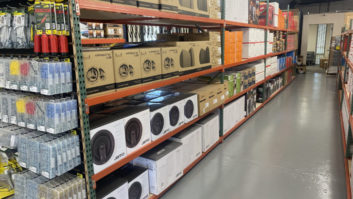TWICE: How have digital camera sales been so far this year?
Bo Kajiwara, Nikon: Nikon has had strong sales across all product lines this year, including our robust DSLR lineup, our Nikon 1 series of Advanced Camera with interchangeable lenses, and our CoolPix line of compact digital cameras. In fact, in its first year of sales, the Nikon 1 J1 has consistently achieved the top sales position, and the outlook for the future is very positive as we continue to expand the system. We have also solidified our position within the compact market, continuing to increase market share, with a broad line of CoolPix SKUs that fit the needs for a variety of consumers. From customers seeking a rugged camera or ultra-zoom, to those seeking a simple highquality compact, Nikon has a model for everyone. The DSLR segment is also doing very well for us, including the pro, enthusiast and entry-level segments. While the D3200 is a favorite of those with a blooming interest in photography, the D800 and D4 remain the top choice for advanced shooters and pros.
Stefan Guelpen, Panasonic: The point-and-shoot business has been very challenging – the compressing market has created faster price and volume erosion as we anticipated. Long-zoom and tough [cameras] are two categories that are still performing to expectations. Long-zoom, tough and bridge cameras are doing well – we believe because there is a clear differentiation from smartphones.
Ron Gazzola, Samsung: Sales are meeting our expectations in a challenging market. We are particularly proud that we have been able to differentiate and lead by providing unique and compelling benefits with our new Smart cameras with built-in Wi-Fi. We have found that many users are discovering the joys of photography from their cellphone, and then become frustrated with its limitations. They want the ability to take better quality pictures but don’t want to give up the sharing capability they’ve come to love. Our Smart cameras deliver both.
Scott W. Hardy, Polaroid: For Polaroid, sales have been very strong for both our instant and our more traditional digital imaging products. We’ve considerably expanded our product range and secured additional placement with several major brick-and-mortar and online retailers for our still cameras and camcorders and launched new products in our instant camera range.
For us, products that fulfill a particular need or appeal to a specific target consumer have been our top performers. Examples are our waterproof models, such as the iF045 dual-screen waterproof camera, and our bridge cameras like our iS1250 compact bridge camera, which offers 50x enhanced optical zoom and HD video. Of course, the recently introduced Z2300 digital instant camera has been met with huge enthusiasm as well. This is consistent with our experience historically and with our brand DNA. Polaroid has always been about delivering a unique value proposition to consumers and retailers alike. This is most recognizably embodied in our instant product range, as Polaroid is universally known for being the brand that invented and perfected instant photography. But it extends to every product in the Polaroid product assortment, and we’ve had the greatest success with the products that offer consumers what other’s don’t – be it a unique technology, special functionality that only Polaroid offers, or a combination of feature set, price point and ease of use. That unique value proposition is a key driver behind our success.
Paul Meyhoefer, General Imaging: General Imaging has continued to focus on providing richly featured cameras at affordable price points. This not only represents a strong value proposition for today’s savvy shoppers, but also has allowed significant growth in areas where the market continues to shrink as a result of smart devices. In 2012, General Imaging’s GE digital camera brand continues to be one of the fastest-growing midtier camera brands in the market.
Compact long-zoom and bridge cameras continue to be the main areas of growth for General Imaging in 2012. Leveraging the GE Brand in digital cameras, by offering more features and more value, is a very powerful position for today’s comparison shoppers. Increased awareness among consumers and GE camera owner satisfaction have helped GIC increase not only sales volume, but expand model selection within nationwide retailers while mainstream camera brands are shrinking if not vanishing all together.
Mark Sherengo, Pentax Ricoh Imaging Americas: We’ve seen strength in the waterproof category. Additionally, the interchangeable-lens category (ILC) continues to be a strong segment. The waterproof sector has been a top performer for us. Everyday life presents challenges and consumers need a camera to handle the various conditions they face on a daily basis. Additionally, we have found success with the ILC sector because of the high quality of images that these cameras produce. Finally, the high-end compact sector has performed well due to the large number of photo-enthusiasts who are looking for more advanced features than low-end compacts offer in what many enthusiasts consider a back-up camera. These features include higher-quality optics, more customization and enhanced control over exposure.
Liz Cutting, The NPD Group: Overall, digital camera sales were down 8 percent in revenue but 24 percent in units in the first half of 2012. It’s very telling that the average price of a camera went from $251 to $305, as the proportion of higher end cameras has increased at a great clip. Interchangeablelens cameras achieved more than half of total camera revenue, at 56 percent of all camera dollars spent in the US market in the first half of 2012. But that doesn’t leave compact cameras down and out. In fact, across NPD’s three-year data of record, in the months of June and July, compact cameras hit new high points in average price.
Interchangeable-lens cameras as a whole were up 7 percent in units and 13 percent in dollars in the first half of 2012. Despite DSLRs’ supply problems from the spring of 2011, the segment was still up 6 percent in dollars from the first half of 2011 to 2012, largely with the influx of prosumer models in the spring of 2012. Mirrorless interchangeable-lens cameras served to bolster the whole ILC segment, doubling in importance to reach 16 percent of all ILC units in the first half of 2012. The majority of mirrorless influence is in the sub-$600 price point, but we’re also seeing more diversification into the $1,200-plus price point levels. The compact market is exciting in areas where it can blow doors on smartphones, specifically within waterproof, longer zooms and larger sensors, and we’ve seen growth in $300+ average price point models.
Chris Chute, IDC: Trends/sales for stand-alone cameras and camcorders are generally declining. Part of the reason is market maturity, yet another reason is that many of these cameras are still unconnected. Consumers are really embracing connectivity, and imaging vendors have been at a loss as to how to address that. We’re seeing another 18 percent drop on compact camera sales for this year. Interchangelable-lens cameras, particularly DSLRs, continue to do very well in the U.S. Mirrorless models are appealing to more advanced ILC users looking to try out the form factor. This differs from trends in other countries, where mirrorless models are being taken up by compact camera users looking to upgrade for the first time. Point-of-view or action sports camcorder are doing very well.












